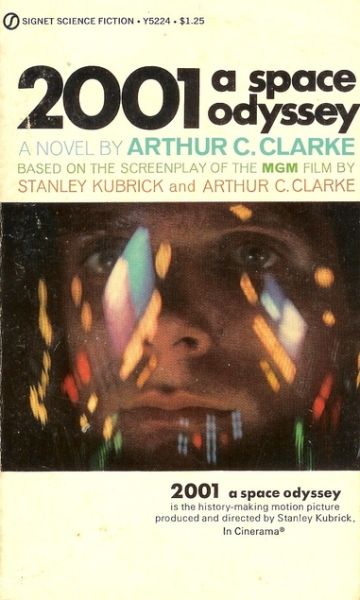Millennial Review VIII: 2001: A Space Odyssey by Arthur C. Clarke (1968)
2001: A Space Odyssey
By Arthur C. Clarke

22 Jan, 2000
0 comments
2001: A Space Odyssey
Arthur C. Clarke
Signet, 1968
221 pages
I remember this as a light read and it is, even more so than I recalled. It still is a counter example to the colon rule, being quite readable even now, so long after its writing that people who were children when it came out are old and wrinkly now.
Synopsis: The plot is divided into three main sections.
In the first, Moon-Watcher, a “man-ape”, lives with his family-clan, barely able to scratch out a living in the harsh Africa of three million years ago. They encounter an anomolous object, a black monolith, which changes them mentally and genetically. Moon-watcher and his clan are taught simple tool making and manufacture, Moon-watcher uses his new skills to find food and to kill, first for food, then for protection against a leopard and finally to eliminate a hated rival.
Three million years later in the early 21st century, Dr Heywood Floyd travels to the Moonbase in Clavius. There another monolith has been found, buried under the lunar surface. Soon after it is dug up, it gives off a loud signal, apparently targeted near Saturn.
Soon after, we meet Poole and Bowman, astronauts on their way to Saturn. With them are three companions, frozen in cold sleep, and HAL, a highly advanced and intelligent computer. The first part of the trip to Saturn is relatively uneventful but a communications problem develops. It is traced back to HAL. In the course of attempting to deal with the situation, Poole is killed by a space craft under HAL’s command. When Bowman attempts to wake up a replacement for Poole, HAL opens the airlock doors, killing the three sleepers and nearly killing Bowman. To protect himself in the short run, Bowman destroys HAL’s higher functions. This means that Bowman cannot go into hybernation to wait for the return mission back to Earth and will die out by Saturn.
Bowman is informed about the monolith on the Moon. HAL has apparently been driven mad by conflicting orders concerning the mission and the need to maintain secrecy. Bowman attempts to complete the mission on his own. He discovers a much larger monolith in orbit around Saturn. It opens a stargate and he is drawn through, eventually arriving at a habitat in red giant star. He is reshaped as Moon-watcher was, becoming something as advanced over humans as we are over animals. The new entity returns to Earth and after destroying a nuclear missle aimed him, ponders what he will do with the Earth, in a parallel with Moon-watcher’s final musings in his section.
Forgive any terseness: I have a migraine coming on.
This is, despite its fame, minor Clarke in my opinion. Many of its themes he used first elsewhere, especially the ending where humanity is displaced by a far more advanced successor or perhaps eaten by it, depending on how one views the conclusion of Childhood’s End. It is still quite readable, having few of the flaws that mar his more recent books and with all of the tell-tale Clarkeian stylistic quirks. It is also more optimistic than I remember it, aside from the trivial point that humanity is doomed as soon as Bowman is transformed: up until then, we had been doing fairly well.
This is another 2000 where we are far more advanced than in OTL and not just in space: these people have not only relatively inexpensive space travel but the basis of AI occurs in 1980. While they have something vaguely akin to the web in the form of newspads, these are receive-only, not interactive.
